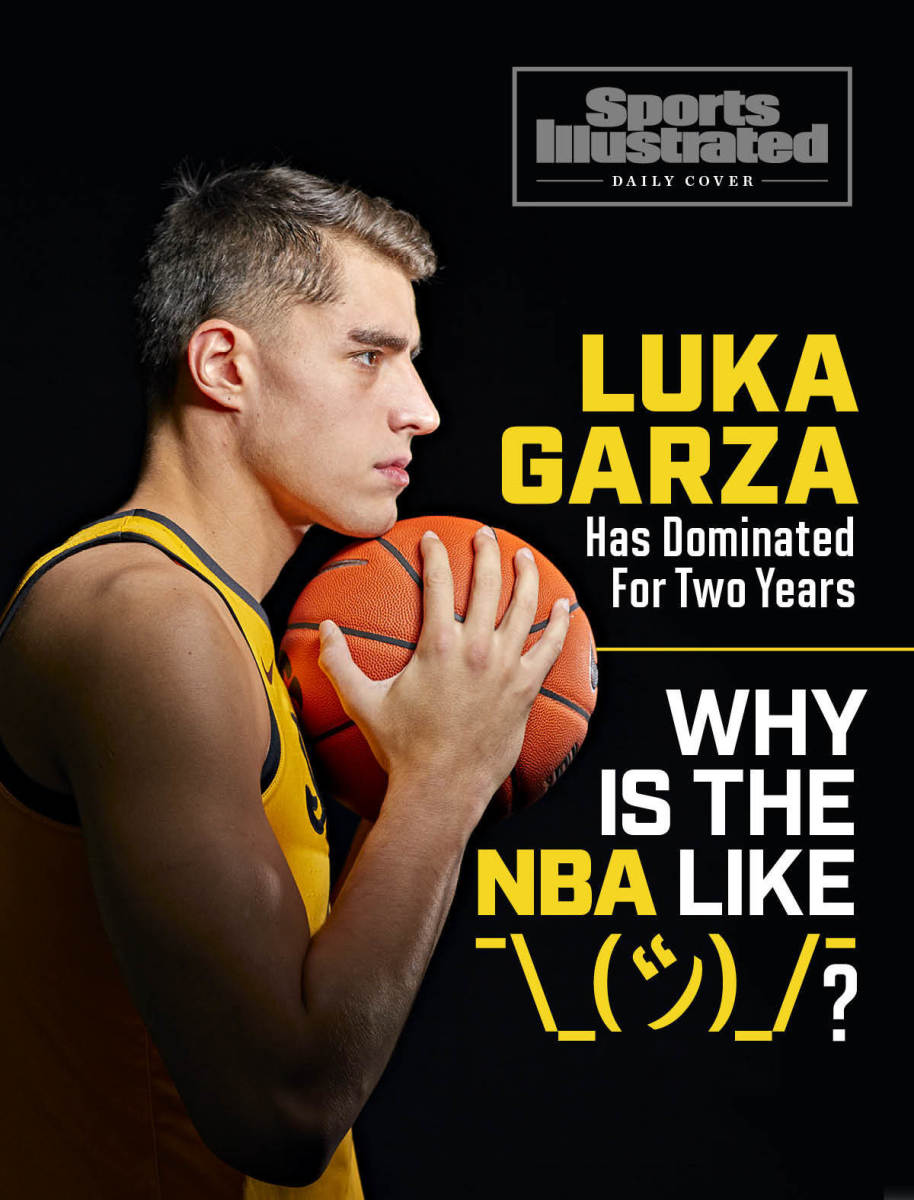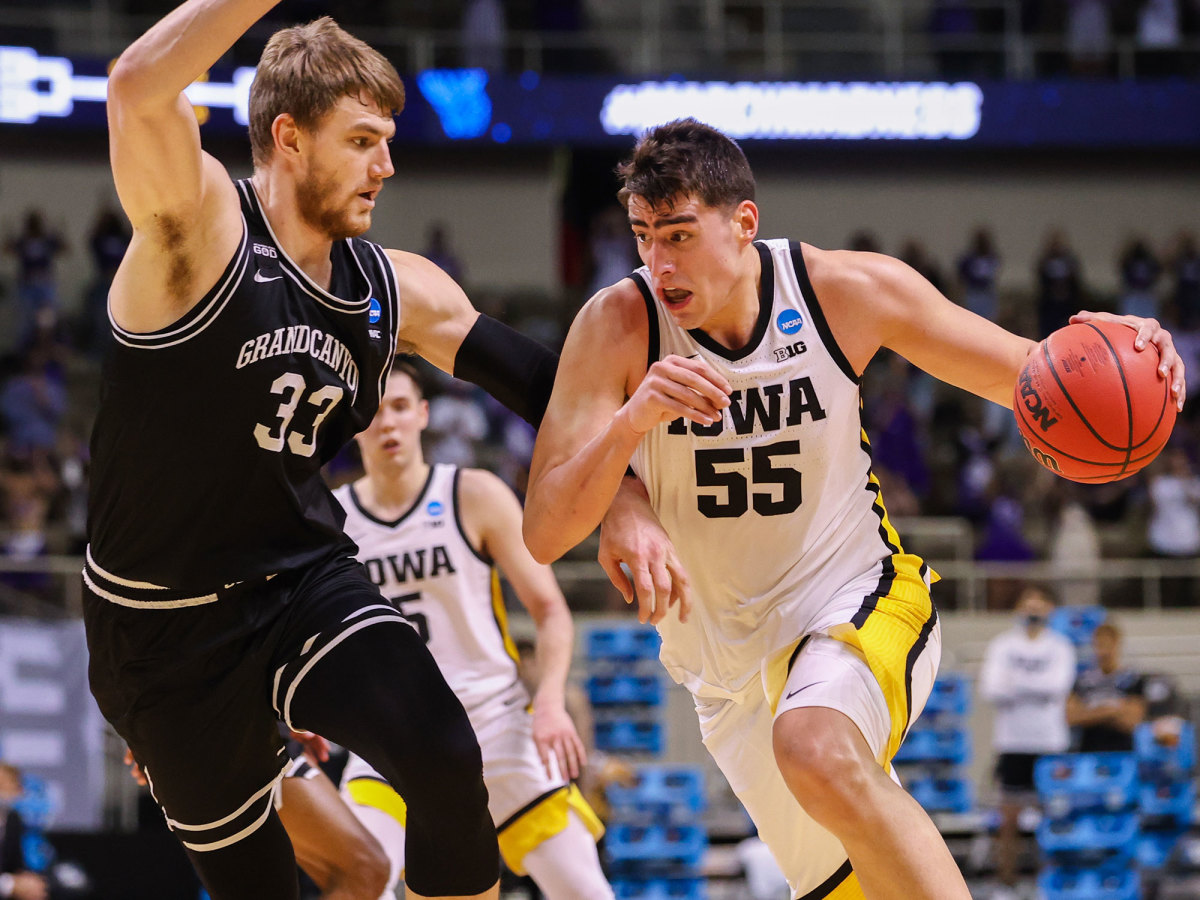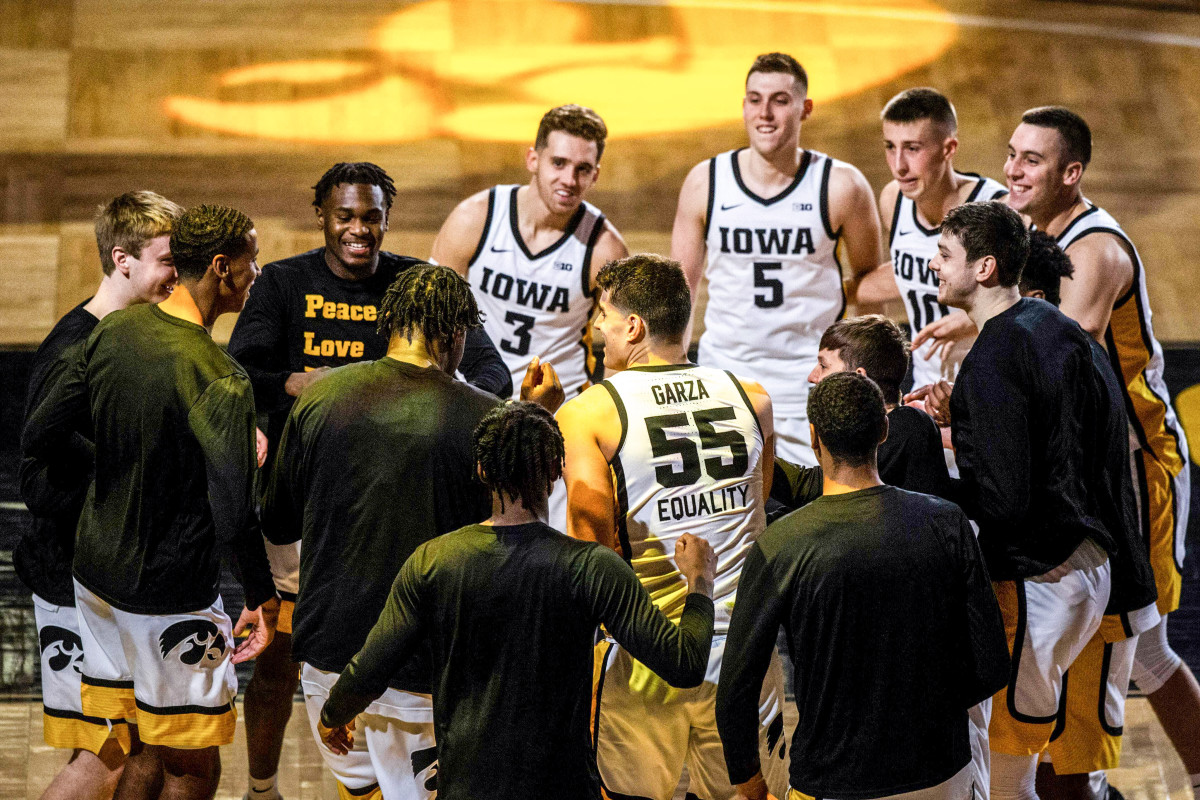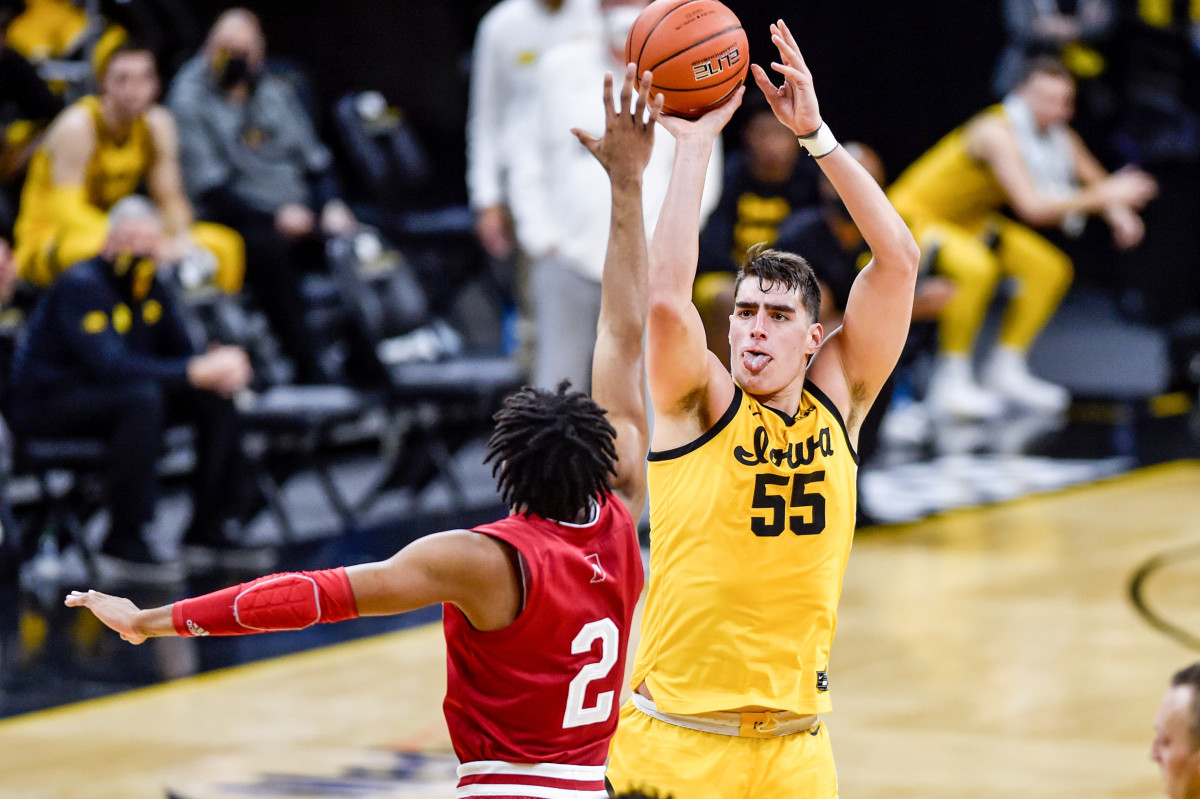Luka Garza's College Legacy Speaks for Itself. Will It Matter in the NBA?
There is simply not much left for Luka Garza to prove, not to college basketball’s cognoscenti nor the common fan, not after two years of unfettered interior dominance in the most physical league in the country—and no matter his Iowa Hawkeyes’ eventual fate. Pick an award headed his way, and he probably won it last year. He now has a 2021 tournament win under his belt, after Garza and his second-seeded Hawkeyes advanced comfortably past No. 15-seed Grand Canyon on Saturday.
We’ve witnessed it time and again, Garza’s burly shoulders bumping and bruising against hordes of Big Ten centers, his footwork somehow bordering on dainty, with Iowa winning more often than not. His jumper has become just as reliable, and the Hawkeyes move him all over the floor—the gameplan was to pick-and-pop GCU and 7-footer Asbjorn Midtgaard into oblivion, and it clicked. Despite some first-half foul trouble, Garza finished with 24 points, six rebounds, and made four of five threes. Despite some occasionally spotty defense, Iowa rolled.

This is all very normal: the Hawkeyes are 42–19 the last two years, with Garza as their centerpiece, and currently boast the nation’s most efficient offense east of Spokane. Heading into the men’s tournament, Garza was averaging 23.7 points and 8.8 rebounds, shooting 55% from the field and 41% from three-point range. Garza is already Iowa’s all-time leading scorer, and may yet break the school single-season points record he set last year if his team can win another game or two. Over the course of the last two seasons, he’s been held to single-digit points in a game just twice. There’s a certain inevitability to the way he attacks opposing teams—whatever he’s able to accomplish in postseason play is gravy, but the history books should mostly speak for themselves.
Perhaps the last bit of mystery still shrouding Garza is what will happen when the NBA comes calling, and what he’ll be able to accomplish when he gets there. Rest assured, scouts have seen everything he can do over the last two years. But as the professional game continues to shift away from the style of play he’s all but perfected, it’s a foregone conclusion that Garza will have to adjust to survive the rigors of the best league on the planet.
A second-round date with Oregon looms Monday, and perhaps a matchup with USC and projected top-five draft pick Evan Mobley after that. An Elite Eight rematch with title favorite Gonzaga would be an all-time opportunity to prove himself further. But in the eyes of the NBA, it may not matter much—accolades and all, Garza seems fated as a second-round pick in this summer’s draft. So, the final question surrounding college basketball’s great unyielding constant is an existential one.

Even the most bullish viewers have to understand the facts: Garza is not especially fast, which is to say, not fast at all. To his credit, he sprints hard from end to end and makes the most of what he has. Human feet can cover only so much ground in so much time. His 6' 11", 265-pound frame is of the heavier sort. Garza is a senior and turns 23 in December, which conventionally suggests there’s not much athletic development left.
The ability to move—or lack thereof—can, for obvious reasons, be a debilitating weakness in the NBA, which features many of the best athletes in the world and continues to break new ground when it comes to pace of play. One trend across Iowa’s losses this season has been the presence of a quality opposing center and, to put it lightly, Garza did not have a fun time guarding Illinois center Kofi Cockburn (listed at 7' 0", 285 pounds) in the Big Ten tournament. Garza does average 1.9 blocks per 36 minutes, and he’s certainly not the only defensive liability in Iowa’s rotation. But as a center in the pick-and-roll heavy NBA, his versatility will be minimal.
“Even looking at it favorably, I don’t think he can go in the first round. But I do think he has to get drafted,” says one Western Conference executive. “There’s too much positivity around his motor, production and who he is as a human being. In the second round, you can’t say you’re not going to think about giving him a chance to find a role. But how many people [in the NBA] will you find who think he’s a first-rounder? Not many.”
Garza has certainly earned whatever opportunity comes to him: he shoots close to 70% around the rim, per analytics site BartTorvik.com, and averages an efficient 1.13 points per possession on post-ups, per Synergy. “He’s the focal point of every defense every time we take the floor,” says Iowa coach Fran McCaffery. “The more tape that’s on him, the tougher that gets [for him]. I’ve been really impressed with his relentlessness to continue to improve and handle anything that comes his way, from a defensive scheme or physicality perspective. He just keeps on coming. When you think he’s maxed out, he just amazes you again and proves that there’s more there.” Iowa supports Garza with quality three-point shooters, and has flashed an improved team defense in recent weeks as well.

“I don’t think you can underestimate [Garza]. … The guy manufactures low-post points,” adds the Western Conference executive. “If you want to go on history, the answer is no, because he’s just not bouncy enough. But if you think outside the box, maybe there’s a way. The odds are against him, but I wouldn’t definitely say it’s not gonna happen. He’s unique. Would I take him at [pick] 29? No. But I would not count this dude out completely. Maybe he can figure out how to succeed with his physical limitations. He comes across as a bright guy. He’s self-aware enough to know.”
The catch here is that a center’s chances of sticking in the NBA hinge less than ever on back-to-the-basket skills. Post-play has been popularly characterized as a dying art, but in truth, teams have simply become more judicious about which players are worth playing through. NBA.com’s vast archives of player tracking data run back to the 2013–14 season, in which nine players received more than 10 post touches per game, and 27 averaged more than six. Entering this year’s All-Star break, just two players—Joel Embiid and Nikola Vučević—were above that 10-touch threshold, and a mere eight in total enjoyed a nightly diet of six or more post-ups. That list also comprises Nikola Jokić, Karl-Anthony Towns, Anthony Davis, Andre Drummond, Domantas Sabonis and Kawhi Leonard, all of whom are established, multiple-time All-Stars. All were younger than Garza when they entered the league.
Noting that trend, and the likelihood that Garza’s minutes are inhibited by defensive shortcomings, suffice it to say he will not garner that sort of usage in the NBA. For comparison, consider Trail Blazers center Enes Kanter, one of the few remaining nonstar centers who plays significant minutes and can be classified as an offensive specialist, averages a mere 2.1 post-ups in his 27 minutes per game. Kanter has attempted only eight jump shots this season, per Synergy, but he’s also one of the league’s elite offensive rebounders, averaging 5.6 per 36 minutes. The best role players adapt to their surroundings or risk obscurity. Teams are parsing for themselves whether Garza can make that leap.

“Most players don’t [post up] anymore because that’s just not how most offenses run,” says one Eastern Conference executive. “The guys that do are so good that they should be getting those touches because that’s just the best way [for their teams] to score. But it’s not the way teams derive offense anymore, and that’s not how Garza’s going to carve out his niche. He’s not athletic enough to pull that stuff off against length and size at the rim. Inside is not gonna be where he’s most effective, other than carving out space as an offensive rebounder. Most teams don’t even double the post.”
Although offenses have changed, there remains no shortage of demand for size on draft night. In 2020, six nominal bigs were among the first 20 picks, and 11 among the first 40. Positional supply and demand shifts from year to year, but the NBA is going to select the best prospects available. As one league executive put it to me years ago: “We can only draft what’s there.”
“When I think about transitioning to the professional level, I have no doubt in my mind I’ll be able to make it,” Garza says. “I’m just gonna work as hard as I can and do whatever I can, whatever a team needs, to be successful. Whatever role that is, however I have to play … obviously, I play a lot in the post in college, and that’s something I love to do, but the game is kind of moving away from that in the NBA. I think I’m a good enough three-point threat to be able to score from the outside as well, and I’m just as confident in my outside game as I am in my inside game.”
Garza’s improved three-point shot, now up to 40.7% on the season after hitting 35.8% as a junior, has been a legitimate weapon, and he’s proven capable of hitting tough midrange shots as a viable counter. It also helps that he can lean on a strong array of auxiliary skills. He’s established himself as an exceptional offensive rebounder, by dint of his soft hands and how much space he occupies. According to Boost Sport’s data, Garza’s 10.3% offensive rebound rate ranks in the 86th percentile nationally and he owns a 39.8% free-throw rate, drawing about six fouls per game. It’s not just his success but also the variance in his interior points that may be encouraging. It’s just that his athleticism has to translate, as his usage inevitably becomes more situational.
If there’s a recent indicator of hope, the Utah Jazz maneuvered to select Kansas’s Udoka Azubuike, a four-year college center who projected as a specialist, with the 27th pick in the 2020 draft. Azubuike’s skill set as an oversize defender scales more cleanly than Garza’s specialized offensive toolbox, but it’s more the concept that matters—both project as matchup-dependent backup centers, with utility ideally specific to their coach’s system. After a certain point in a given draft, situational fit can be a trump card, particularly for playoff teams that know exactly what they want to add to their roster.
“The evaluation has to be team-specific, relative to how they want to play defense, especially in the second unit,” says the Eastern Conference executive. “I think the guy, if he goes to the right situation, he’s gonna be a good NBA player. I’m not saying an All-Star, but can [Garza] be like what Mason Plumlee has been? Because some of the things he does do are really valuable. He can pick-and-pop, shoot threes. He’s a f------ animal on the boards, monster screener, and in the playoffs that matters.

“Now if [Garza] has to hedge and recover, switch screens, then he’s not going to make it,” the Eastern Conference executive adds. “If you play drop coverage and use him the right way, he can make money. Defensively, the game is so totally different in the NBA; it’s more about the system he’s going to play in and his ability to function within it. It’s not necessarily about his ability to one-on-one guard someone because [defenses] are so intricate with rotations. But he can meet guys at the rim, and I think he’ll be a charge-taker, just not a shot blocker protecting the basket. That’s not who he is.”
Garza is also a steady passer out of double teams and rarely makes mistakes. According to BartTorvik.com, Garza is one of just three major-conference players since 2008 to post a usage rate north of 30% with a turnover rate less than 10%, joining Doug McDermott and Luke Harangody. Garza is also one of two centers since 2008 to post a PRPG score (BartTorvik’s adjusted metric that measures points over replacement value) of 6.9 or higher and a box plus-minus rating (estimating a player’s on-court contributions using box score data) greater than 12.0, the other being Frank Kaminsky. If none of that made any sense to you, reader, just know that the advanced stats support just how much of an impact he makes.
Of course, those numbers don’t guarantee a thing. Most of Garza’s contributions come on offense, where on most nights, his work eclipses whatever he gives up on the other end. In the NBA, the bar for basic defensive survival is much higher. Even the best bigs aren’t immune. For every Sabonis or Jakob Poeltl, who transitioned successfully from post-up heavy college stars to NBA starters (and in Sabonis’s case, an offensive focal point), there’s a Jahlil Okafor or Jared Sullinger, whose physical limitations affected their longevity and path to value. Where Garza falls on that spectrum remains to be seen. What we do know is that he will go down as one of the most prolific college centers ever. For what it’s worth, he’s as known a quantity as you’ll find in this draft.
“At this point, I don’t think there’s anything different he can show,” adds the Western Conference executive. “There’s just not anything left to see on the offensive end. He’s added the shot to his game. He shoots with almost as much confidence as he scores in the low post. There’s risk [of getting exposed] on defense. Maybe this is a stretch, he maybe can help himself by winning a good individual matchup [in the NCAA tournament]. I mean, whether he averages 33 and 11 or 19 and 7, if they go to the Sweet 16, it’s [still] kind of been there, done that.”
If we’re splitting hairs here, Garza hasn’t actually been to the Sweet 16—not yet. Iowa’s overtime loss to Tennessee in the 2019 tourney, when he was a sophomore sharing interior touches with future NBA player Tyler Cook, still bothers him.
“Since [that game] two years ago, it’s just been in my head, getting back to that moment and coming out on the [winning] end,” Garza says. Iowa was likely tournament-bound last year before COVID-19 cut everything short. It sounds a little bleak, but this tournament is his last ride.
So for now, the only thing Garza’s worried about is Oregon. The Ducks enter Monday off a surprise bye, advancing after VCU forfeited its first-round matchup following positive COVID-19 tests within its team. Whether or not he finds a niche in the NBA, college may prove to be Garza’s peak. In the grand scheme, a memorable tournament run may mean a whole lot more than where his name gets called come draft night. The league can wait. Why shouldn’t it?
Read more of SI's Daily Cover stories
SI’s tournament newsletter analyzes everything you need to know about the Big Dance: what just happened and what’s happening next. Sign up for Morning Madness here.
